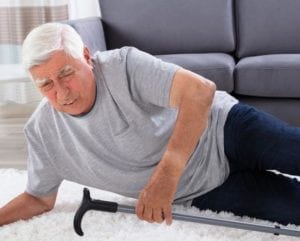The subject of fall prevention for the older adult is not a new one. Numerous programs, studies, and classes focus on this very important issue. Falls among older adults lead to injuries, lowered quality of life, decreased physical and emotional freedom, and even death.
From 2000-2013, the fall injury rate among adults aged 65 and over almost doubled from 29.6 per 100,000 to 56.7 per 100,000. During that same span of time, more than one-half (55%) of all unintentional injury deaths among older adults aged 65 and over were due to falls. Prevention is the key to reversing this trend.
When your organization is establishing a new evaluating an existing fall prevention program, the first thing that must be addressed is your organization’s definition of a fall. Once the definition is clear and the same criteria recognized by everyone, training and data gathering will be more standardized throughout the organization.
Impact of Falls
Individuals and Families
Falls can be physically and emotionally devastating to an individual. When an older adult falls, it can cause injury, even death. The societal effects of a fall can be life changing.
Once a fall has taken place, the person is known as a “fall risk” and has the possibility of losing individual freedom in daily tasks. For the family, a fall means that they are now on constant alert to keep it from happening again. Family members can become very overprotective, leaving the individual to feel smothered, limited, and dependent.
Staff
For all healthcare staff, fall prevention is very important. Any predisposition toward falling can affect treatments. For example, if an individual is performing gait training for a total hip replacement, but was a fall risk before surgery, the treatment might be less intense until the chances of falling are determined. This variable might make the difference between successful and unsuccessful rehabilitation.
The Organization
The focus of any healthcare organization is to provide quality care to individuals within a safe environment. If there are numerous falls at an organization’s facility, quality care and safety are not going to appear to be priorities. The cost of recovery from falls and the liability factors involved with serious falls are two additional reasons organizations take an interest in fall prevention programs.
Interdisciplinary Team Approach for Fall Prevention
Many organizations rely on only therapists and nurses for fall prevention. However, there are other members of the interdisciplinary team (IDT) who can contribute in meaningful ways.
Individuals
Some of the frontline members should be the individuals themselves. It is imperative that they share their fall history with the IDT because a previous fall is a reliable predictor of another fall. Many times individuals will not report a previous fall for fear of limiting their independence. You might have to ask!
Families
Families can be a good source of information when it comes to asking about activities of daily living and how the individual is navigating them. Ask if there are any hobbies that the individual has recently given up due to balance issues. Are they going out or staying at home a great deal? When they are out in the community, how well do they get in and out of cars, walk on sidewalks, or navigate curbs and stairs?
Physicians
Physicians are important team members to include in the fall risk assessment process. Instead of asking, “Have you had any falls lately?” the Centers for Disease Control and Prevention (CDC) suggests that the physician ask, “In the past 12 months, how many times have you fallen?” If the answer is more than once, the next question should be, “How many of these falls caused an injury where you needed to be seen by a medical professional, or that limited your activities of daily living?”
Nurses
Nurses can be the eyes and ears to determine if the individual is unsteady when walking or has difficulty with sit-to-stand motions. They can notice if the person squints to see things at a distance, indicating vision problems. They also have the ability to identify potential medication side effects or interactions that might cause falls.
Therapists
Physical therapists and occupational therapists are both important parts of the fall prevention team. They perform assessments that assess balance, strength, endurance, and range of motion, among others. They look at gait steadiness and speed, and perform tests that will give a baseline for performance.
Home Safety
Home safety assessment and modifications have been shown to help decrease both the rate and risk of falling. Walking aids may need to be given, along with training to use the aids. Bathroom tools for transfers might need to be brought in. Those living in a healthcare facility will get hands-on help to make their living environments safer to navigate.
As our society ages, more of the population will need to be concerned about fall prevention
Everyone is a part of the fall risk prevention team and everyone has an equally important role. The individual is responsible for following through with treatment and reporting any changes that might increase their fall risk. The family must report any changes and work as a support system for the individual. Those on the medical staff play many roles according to their field and must learn to think in terms of decreasing fall risk factors for each individual.
Fall prevention is a very important aspect of caring for older adults. They are the generation who taught us how to walk, and now it is our turn to help them stay steady. It is worth the effort it takes to develop a fall prevention program to keep them safe and confident as they live out their golden years!

Post-Acute and Long-Term Care
For more information on all our learning and development solutions, visit our website.
Read more →






